The Electrochemical Behavior of Unmodified and Pd-NPs Modified AB5 Hydrogen Storage Alloy in Selected Protic and Aprotic Ionic Liquids (ILs): Towards ILs-Based Electrolytes for Ni-MH Batteries
Abstract
1. Introduction
2. Results
2.1. Physicochemical Properties of DEMA-TFO and 1 M HMS/EMIm-MS
2.2. Electrochemical Behavior of AB5/AB5-Pd-NPs in DEMA-TFO and 1 M HMS/EMIm-MS
2.3. Hydrogen Absorption Capacities
2.4. Physicochemical Analysis of AB5 Electrodes
3. Conclusions
4. Materials and Methods
4.1. Materials
4.2. Methods
Supplementary Materials
Author Contributions
Funding
Institutional Review Board Statement
Informed Consent Statement
Data Availability Statement
Conflicts of Interest
Sample Availability
References
- Mohtadi, R.; Orimo, S. The renaissance of hydrides as energy materials. Nat. Rev. Mater. 2017, 2, 16091. [Google Scholar] [CrossRef]
- Kåberger, T. Progress of renewable electricity replacing fossil fuels. Glob. Energy Interconnect. 2018, 1, 48–52. [Google Scholar] [CrossRef]
- Ouyang, L.; Huang, J.; Wang, H.; Liu, J.; Zhu, M. Progress of hydrogen storage alloys for Ni-MH rechargeable power batteries in electric vehicles: A review. Mater. Chem. Phys. 2017, 200, 164–178. [Google Scholar] [CrossRef]
- Maeda, K.; Yae, S.; Fukumuro, N.; Iimura, K.; Matsumoto, A. Development of a liquid immersion-type nickel-metal hydride battery under high-pressure. J. Electrochem. Soc. 2021, 168, 120511. [Google Scholar] [CrossRef]
- Vassal, N.; Salmon, E.; Fauvarque, J.-F. Nickel/metal hydride secondary batteries using alkaline solid polymer electrolyte. J. Electrochem. Soc. 1999, 146, 20–26. [Google Scholar] [CrossRef]
- Young, K.; Yasuoka, S. Capacity degradation mechanisms in nickel/metal hydride batteries. Batteries 2016, 2, 3. [Google Scholar] [CrossRef]
- Zaluski, L.; Zaluska, A.; Tessier, P.; Ström-Olsen, J.O.; Schulz, R. Catalytic effect of Pd on hydrogen absorption in mechanically alloyed Mg2Ni, LaNi5 and FeTi. J. Alloys Compd. 1995, 217, 295–300. [Google Scholar] [CrossRef]
- Williams, M.; Lototsky, M.; Nechaev, A.; Yartys, V.; Solberg, J.K.; Denys, R.V.; Linkov, V.M. Palladium mixed-metal surface-modified AB5-type intermetallides enhance hydrogen sorption kinetics. S. Afr. J. Sci. 2010, 106, 310. [Google Scholar] [CrossRef]
- Xie, D. Effect of surface coating on electrochemical properties of rare earth-based AB5-type hydrogen storage alloys. Int. J. Electrochem. Sci. 2016, 11, 9153–9163. [Google Scholar] [CrossRef]
- Modibane, K.D.; Lototskyy, M.; Davids, M.W.; Williams, M.; Hato, M.J.; Molapo, K.M. Influence of co-milling with palladium black on hydrogen sorption performance and poisoning tolerance of surf.ace modified AB5-type hydrogen storage alloy. J. Alloys Compd. 2018, 750, 523–529. [Google Scholar] [CrossRef]
- Hubkowska, K.; Soszko, M.; Krajewski, M.; Czerwiński, A. Enhanced kinetics of hydrogen electrosorption in AB5 hydrogen storage alloy decorated with Pd nanoparticles. Electrochem. Commun. 2019, 100, 100–103. [Google Scholar] [CrossRef]
- Ruiz, F.C.; Martínez, P.S.; Castro, E.B.; Humana, R.; Peretti, H.A.; Visintin, A. Effect of electrolyte concentration on the electrochemical properties of an AB5-type alloy for Ni/MH batteries. Int. J. Hydrogen Energy 2013, 38, 240–245. [Google Scholar] [CrossRef]
- Yan, S.; Young, K.; Simon Ng, K.Y. Effect of salt additives to the KOH electrolyte used in Ni/MH batteries. Batteries 2015, 1, 54–73. [Google Scholar] [CrossRef]
- Yang, C.-C. Polymer Ni-MH battery based on PEO-PVA-KOH polymer electrolyte. J. Power Sources 2002, 109, 22–31. [Google Scholar] [CrossRef]
- Sun, S.; Song, J.; Shan, Z. Electrochemical properties of low molecular weight gel electrolyte for nickel/metal hydride cell. Electrochim Acta 2014, 130, 689–692. [Google Scholar] [CrossRef]
- Welton, T. Ionic liquids: A brief history. Biophys. Rev. 2018, 10, 691–706. [Google Scholar] [CrossRef]
- Singh, S.K.; Savoy, A.W. Ionic liquids synthesis and applications: An overview. J. Mol. Liq. 2020, 297, 112038. [Google Scholar] [CrossRef]
- Lewandowski, A.; Świderska-Mocek, A. Ionic liquids as electrolytes for Li-ion batteries-an overview of electrochemical studies. J. Power Sources 2009, 194, 601–609. [Google Scholar] [CrossRef]
- Vogl, T.; Menne, S.; Balducci, A. Mixtures of protic ionic liquids and propylene carbonate as advanced electrolytes for lithium-ion batteries. Phys. Chem. Chem. Phys. 2014, 16, 25014–25023. [Google Scholar] [CrossRef]
- Huie, M.M.; DiLeo, R.A.; Marschilok, A.C.; Takeuchi, K.J.; Takeuchi, E.S. Ionic liquid hybrid electrolytes for lithium-ion batteries: A key role of the separator-electrolyte interface in battery electrochemistry. ACS Appl. Mater. Interfaces 2015, 7, 11724–11731. [Google Scholar] [CrossRef]
- Young, K.; Ng, K.Y.S.; Bendersky, L.A. A technical report of the robust affordable next generation energy storage system—BASF program. Batteries 2016, 2, 2. [Google Scholar] [CrossRef]
- Meng, T.; Young, K.; Wong, D.F.; Nei, J. Ionic liquid-based non-aqueous electrolytes for nickel/metal hydride batteries. Batteries 2017, 3, 4. [Google Scholar] [CrossRef]
- Pająk, M.; Hubkowska, K.; Czerwiński, A. The study of hydrogen sorption in palladium limited volume electrode from DEMA-TFO ionic liquid. J. Electroanal. Chem. 2018, 825, 73–76. [Google Scholar] [CrossRef]
- Pająk, M.; Hubkowska, K.; Czerwiński, A. Nitrate protic ionic liquids as electrolytes: Towards hydrogen sorption in Pd. Electrochim Acta 2019, 324, 134851. [Google Scholar] [CrossRef]
- Pająk, M.; Hubkowska, K.; Czerwiński, A. Hydrogen sorption capacity as a tunable parameter in aprotic ionic liquids. Electrochem. Commun. 2020, 118, 106805. [Google Scholar] [CrossRef]
- Pająk, M.; Hubkowska, K.; Czerwiński, A. Improved hydrogen sorption properties of Pd in protic and aprotic ionic liquids effected by superacid addition. J. Alloys Compd. 2022, 903, 163853. [Google Scholar] [CrossRef]
- Meli, F.; Zuttel, A.; Schlapbach, L. Electrochemical and surface properties of low cost, cobalt-free LaNis-type hydrogen storage alloys. J. Alloys Compd. 1993, 202, 81–88. [Google Scholar] [CrossRef]
- McCune, J.A.; He, P.; Petkovic, M.; Coleman, F.; Estager, J.; Holbrey, J.D.; Seddon, K.R.; Swadzba-Kwasny, M. Brønsted acids in ionic liquids: How acidity depends on the liquid structure. Phys. Chem. Chem. Phys. 2014, 16, 23233–23243. [Google Scholar] [CrossRef]
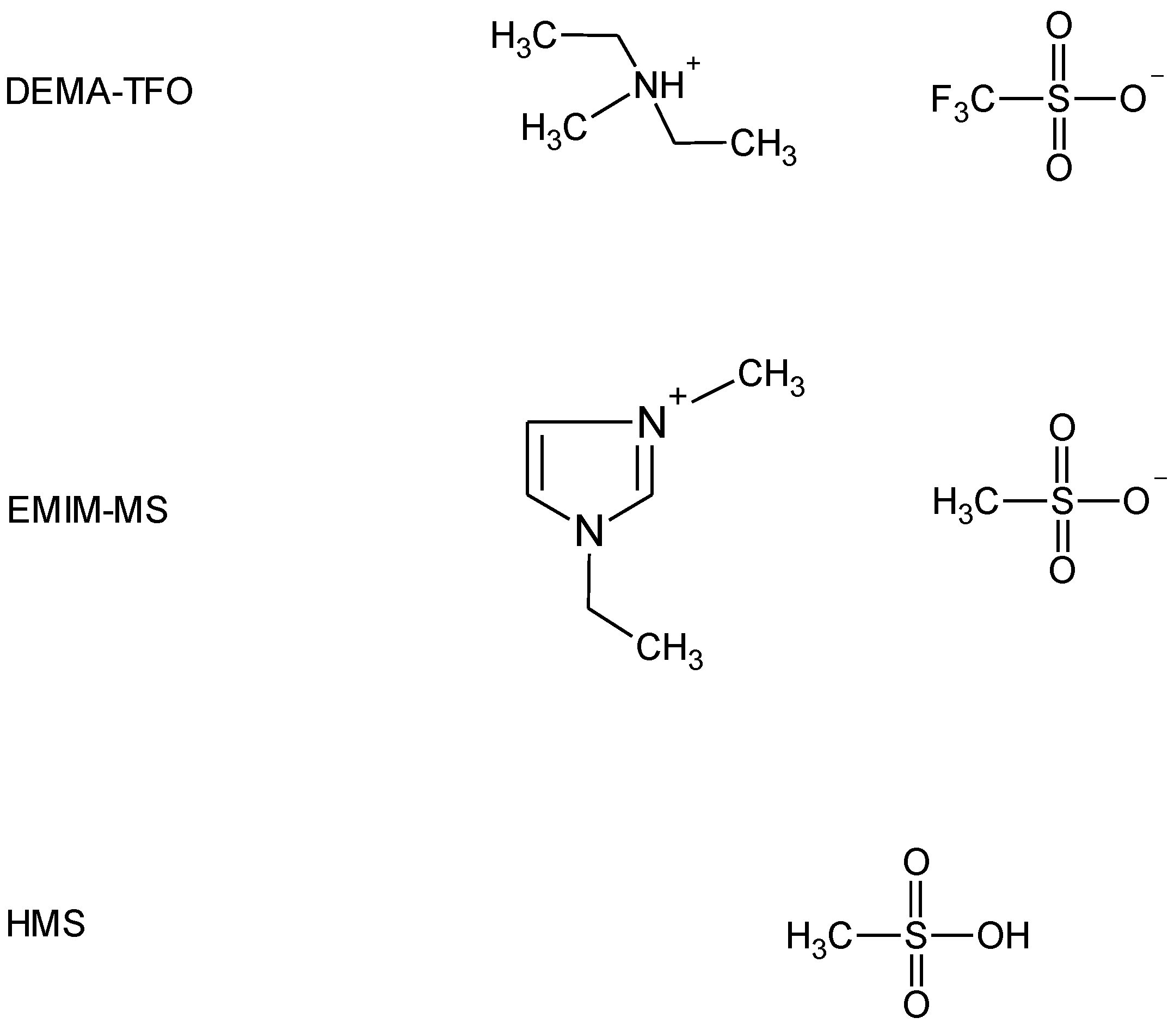

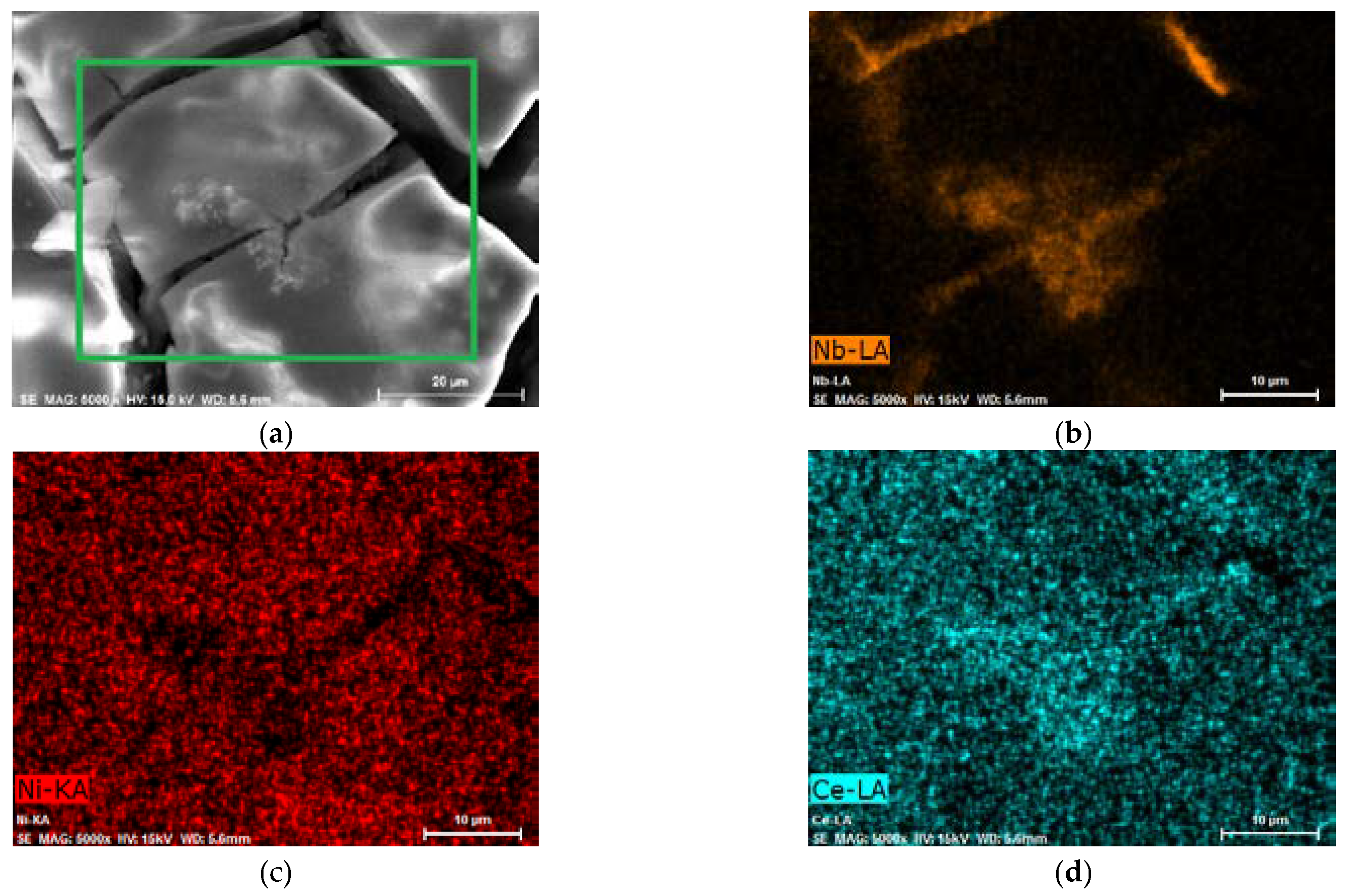
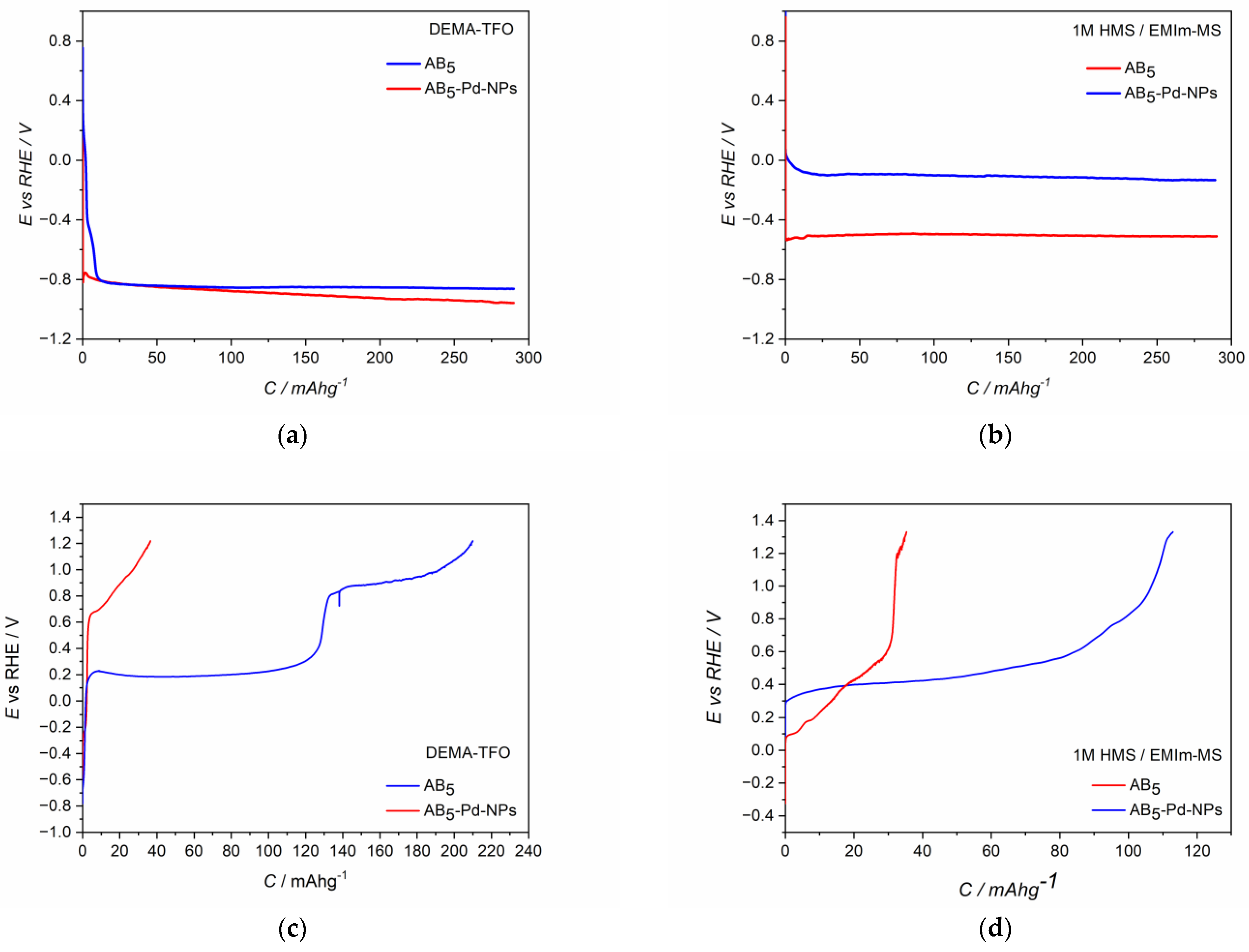
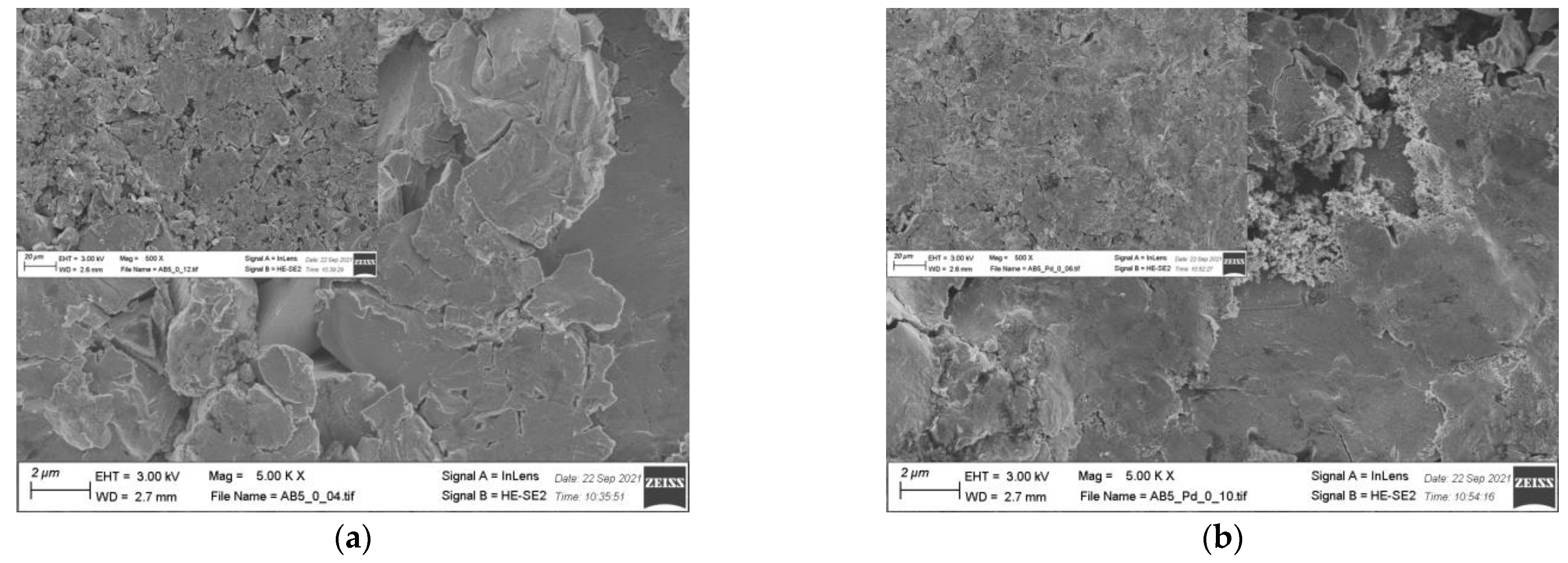
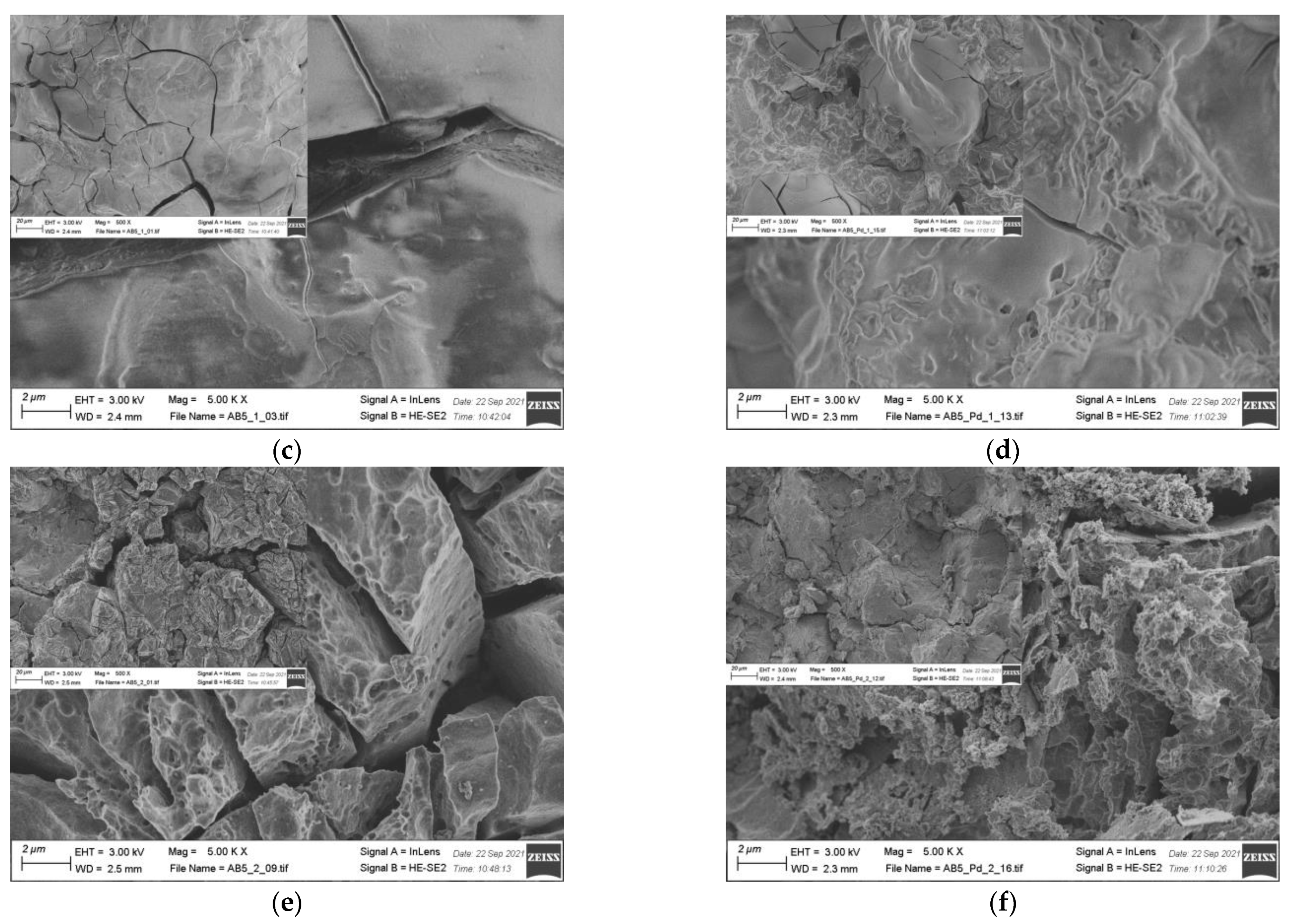
| IL | η/cP | ρ/gcm−3 | σ/mScm−1 | Water Content/wt. %, KF | Electrochemical Window/V |
|---|---|---|---|---|---|
| DEMA-TFO | 58.97 ± 0.62 | 1.27 ± 0.01 | 7.69 ± 0.02 | 0.038 ± 0.001 | (−1.1/3.0) 4.1 |
| 1 M HMS/EMIm-MS | 181.70 ± 3.5 | 1.26 ± 0.01 | 1.66 ± 0.02 | 0.064 ± 0.002 | (−1.9/2.0) 3.9 |
| Sample | EDS/% at. | |||||
|---|---|---|---|---|---|---|
| Ni | La | Mn | Co | Al | Ce | |
| pristine AB5 | 65.5 ± 4.0 | 9.4 ± 0.5 | 6.6 ± 0.4 | 8.3 ± 0.5 | 5.3 ± 0.3 | 4.9 ± 0.3 |
| AB5-Pd-NPs | 74.7 ± 4.0 | 8.2 ± 0.5 | 5.5 ± 0.3 | 7.8 ± 0.4 | 3.6 ± 0.4 | 4.2 ± 0.2 |
| AB5 DEMA-TFO | 63.3 ± 4.0 | 9.7 ± 0.5 | 8.0 ± 0.4 | 8.8 ± 0.5 | 4.2 ± 0.2 | 6.0 ± 0.3 |
| AB5-Pd-NPs DEMA-TFO | 71.8 ± 4.5 | 6.6 ± 0.3 | 4.4 ± 0.2 | 10.3 ± 0.6 | 3.3 ± 0.2 | 3.6 ± 0.2 |
| AB5 1 M HMS/EMIm-MS | 56.7 ± 3.4 | 13.5 ± 0.7 | 9.0 ± 0.5 | 7.9 ± 0.4 | 4.4 ± 0.3 | 8.7 ± 0.4 |
| AB5-Pd-NPs 1 M HMS/EMIm-MS | 66.5 ± 4.0 | 7.9 ± 0.4 | 8.3 ± 0.4 | 9.2 ± 0.5 | 3.9 ± 0.2 | 4.2 ± 0.2 |
| Sample | Capacity/mAh g−1 | |
|---|---|---|
| DEMA-TFO | 1 M HMS/EMIm-MS | |
| AB5 | 40 ± 5 | 40 ± 5 |
| AB5-Pd-NPs | 200 ± 10 | 110 ± 7 |
| Sample | XPS/% at. | |||||
|---|---|---|---|---|---|---|
| Ni | La | Mn | Co | Al | Ce | |
| pristine AB5 | 47.5 ± 3.0 | 24.1 ± 1.5 | 10.1 ± 0.5 | 18.3 ± 1.0 | - | - |
| AB5-Pd-NPs | 70.1 ± 5.0 | 20.1 ± 1.5 | - | 9.8 ± 0.5 | - | - |
| AB5 DEMA-TFO | 43.0 ± 3.0 | 7.6 ± 0.4 | 7.6 ± 0.4 | 13.9 ± 0.7 | 27.8 ± 1.8 | - |
| AB5-Pd-NPs DEMA-TFO | 43.4 ± 3.0 | 9.4 ± 0.5 | 3.8 ± 0.2 | 9.4 ± 0.5 | 34.0 ± 2.0 | - |
| AB5 1 M HMS/EMIm-MS | 50.3 ± 3.0 | 28.8 ± 2.0 | 10.8 ± 0.5 | 10.2 ± 0.5 | - | - |
| AB5-Pd-NPs 1 M HMS/EMIm-MS | 56.3 ± 3.5 | 8.3 ± 0.4 | 12.5 ± 0.7 | 8.3 ± 0.4 | 14.6 ± 0.9 | - |
Disclaimer/Publisher’s Note: The statements, opinions and data contained in all publications are solely those of the individual author(s) and contributor(s) and not of MDPI and/or the editor(s). MDPI and/or the editor(s) disclaim responsibility for any injury to people or property resulting from any ideas, methods, instructions or products referred to in the content. |
© 2023 by the authors. Licensee MDPI, Basel, Switzerland. This article is an open access article distributed under the terms and conditions of the Creative Commons Attribution (CC BY) license (https://creativecommons.org/licenses/by/4.0/).
Share and Cite
Hubkowska, K.; Pająk, M.; Soszko, M.; Czerwiński, A. The Electrochemical Behavior of Unmodified and Pd-NPs Modified AB5 Hydrogen Storage Alloy in Selected Protic and Aprotic Ionic Liquids (ILs): Towards ILs-Based Electrolytes for Ni-MH Batteries. Molecules 2023, 28, 856. https://doi.org/10.3390/molecules28020856
Hubkowska K, Pająk M, Soszko M, Czerwiński A. The Electrochemical Behavior of Unmodified and Pd-NPs Modified AB5 Hydrogen Storage Alloy in Selected Protic and Aprotic Ionic Liquids (ILs): Towards ILs-Based Electrolytes for Ni-MH Batteries. Molecules. 2023; 28(2):856. https://doi.org/10.3390/molecules28020856
Chicago/Turabian StyleHubkowska, Katarzyna, Małgorzata Pająk, Michał Soszko, and Andrzej Czerwiński. 2023. "The Electrochemical Behavior of Unmodified and Pd-NPs Modified AB5 Hydrogen Storage Alloy in Selected Protic and Aprotic Ionic Liquids (ILs): Towards ILs-Based Electrolytes for Ni-MH Batteries" Molecules 28, no. 2: 856. https://doi.org/10.3390/molecules28020856
APA StyleHubkowska, K., Pająk, M., Soszko, M., & Czerwiński, A. (2023). The Electrochemical Behavior of Unmodified and Pd-NPs Modified AB5 Hydrogen Storage Alloy in Selected Protic and Aprotic Ionic Liquids (ILs): Towards ILs-Based Electrolytes for Ni-MH Batteries. Molecules, 28(2), 856. https://doi.org/10.3390/molecules28020856







